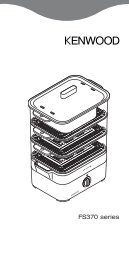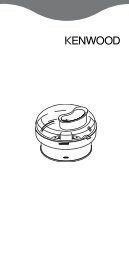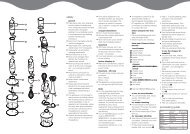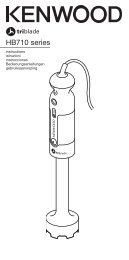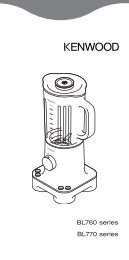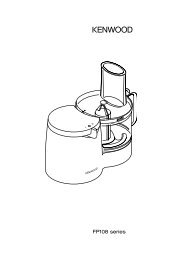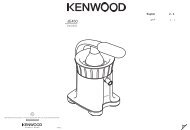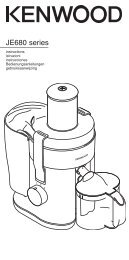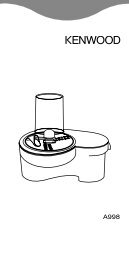Kenwood Limited, New Lane, Havant, Hampshire PO9 2NH, UK ...
Kenwood Limited, New Lane, Havant, Hampshire PO9 2NH, UK ...
Kenwood Limited, New Lane, Havant, Hampshire PO9 2NH, UK ...
Create successful ePaper yourself
Turn your PDF publications into a flip-book with our unique Google optimized e-Paper software.
troubleshooting guide<br />
Following are some typical problems that can occur when making bread in your bread maker. Please review the<br />
problems, their possible cause and the corrective action that should be taken to ensure successful bread making.<br />
PROBLEM POSSIBLE CAUSE SOLUTION<br />
LOAF SIZE AND SHAPE<br />
1. Bread does not rise<br />
enough<br />
•Wholemeal breads will be lower than<br />
white breads due to less gluten<br />
forming protein in whole wheat flour.<br />
• Not enough liquid.<br />
• Sugar omitted or not enough added.<br />
•Wrong type of flour used.<br />
•Wrong type of yeast used.<br />
• Not enough yeast added or too old.<br />
• Rapid bread cycle chosen.<br />
•Yeast and sugar came into contact<br />
with each other before kneading cycle.<br />
• Normal situation, no solution.<br />
• Increase liquid by 15ml/3tsp.<br />
• Assemble ingredients as listed in recipe.<br />
•You may have used plain white flour<br />
instead of strong bread flour which has<br />
a higher gluten content.<br />
• Do not use all-purpose flour.<br />
• For best results use only fast action<br />
“easy blend” yeast.<br />
• Measure amount recommended and<br />
check expiry date on package.<br />
• This cycle produces shorter loaves. This<br />
is normal.<br />
•Make sure they remain separate<br />
when added to the bread pan.<br />
2. Flat loaves,<br />
no rising.<br />
3. Top inflated -<br />
mushroom-like in<br />
appearance.<br />
4. Top and sides cave in.<br />
5. Gnarly, knotted top -<br />
not smooth.<br />
•Yeast omitted.<br />
•Yeast too old.<br />
• Liquid too hot.<br />
•Too much salt added.<br />
• If using timer, yeast got wet before<br />
bread making process started.<br />
•Too much yeast.<br />
•Too much sugar.<br />
•Too much flour.<br />
• Not enough salt.<br />
•Warm, humid weather.<br />
•Too much liquid.<br />
•Too much yeast.<br />
• High humidity and warm weather may<br />
have caused the dough to rise too fast.<br />
• Not enough liquid.<br />
•Too much flour.<br />
•Tops of loaves may not all be perfectly<br />
shaped, however, this does not affect<br />
wonderful flavour of bread.<br />
8<br />
• Assemble ingredients as listed in recipe.<br />
• Check expiry date.<br />
• Use liquid at correct temperature for<br />
bread setting being used.<br />
• Use amount recommended.<br />
• Place dry ingredients into corners of pan<br />
and make slight well in centre of dry<br />
ingredients for yeast to protect it from<br />
liquids.<br />
• Reduce yeast by 1 /4tsp.<br />
• Reduce sugar by 1tsp.<br />
• Reduce flour by 6 to 9tsp.<br />
•Use amount of salt recommended in<br />
recipe.<br />
• Reduce liquid by 15ml/3 tsp and yeast<br />
by 1 /4 tsp.<br />
• Reduce liquid by 15ml/3tsp next time or<br />
add a little extra flour.<br />
• Use amount recommended in recipe or<br />
try a quicker cycle next time.<br />
• Chill the water or add milk straight from<br />
the fridge<br />
• Increase liquid by 15ml/3tsp.<br />
• Measure flour acurately.<br />
•Make sure dough is made under the<br />
best possible conditions.



